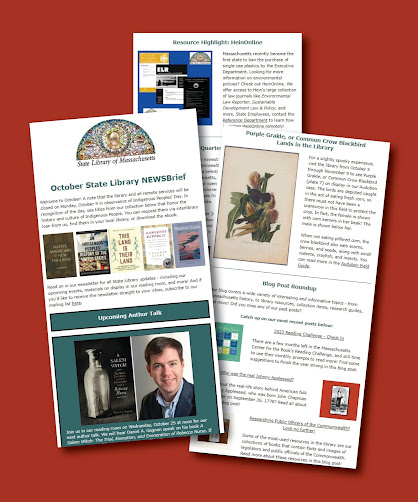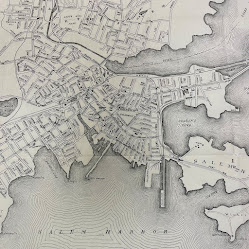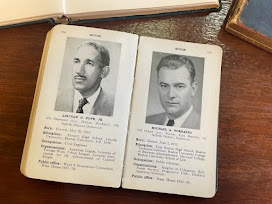It is nearly impossible to think about Fall and Back-to-School without thinking about apples. And an American figure who is closely associated with apples is, of course, Johnny Appleseed. Massachusetts is known for many notable politicians, athletes, and celebrities hailing from the Bay State, but did you know the legendary folk hero was born in Massachusetts? Yes, Johnny Appleseed was a real person—John Chapman. The son of a farmer, he was born in Leominster on September 26, 1774 to Elizabeth and Nathaniel Chapman.
During his childhood Chapman was an apprentice at an apple orchard. His mother and a younger brother had died from tuberculosis when he and his sister were very young. His father, Nathaniel Chapman, remarried in 1780 and would have 10 children with his second wife, Lucy Cooley Chapman. The Chapmans relocated to Longmeadow, Massachusetts where John Chapman lived for the rest of his childhood into early adulthood. In 1792 when Chapman was in his early twenties, he set out to seek his fortune outside of New England along with his younger half-brother. Some accounts say that in addition to Chapman’s half-brother venturing out West with him, his sister Emily joined them.
His first destination was Pennsylvania, specifically the Wilkes-Barre region where he was a nurseryman and orchardist for apple orchards. According to accounts the first orchard he planted was in Warren, Pennsylvania. Now contrary to the myth the apples grown in these orchards were the juicy kind perfect for baking and snacking, the varieties Chapman specialized in growing were apples used for making hard cider. These apples were smaller, less uniform in shape, and sourer than their larger counterparts—hence earning the colloquial term “spitters.” Historians think during the 1790s he also embraced Swedeborgian Christianity and began proselytizing as he journeyed throughout Pennsylvania into the Potomac region of Virginia.

Contrary to the legend, Chapman did not scatter the seeds randomly as he made his way West. Virginia is probably where he collected the seeds for free from the pomace left in cider mills after pressing apples; however, he may also have collected some seeds from Pennsylvania cider mills too. The owners of the cider mills encouraged Chapman to take the seeds from the mills since the more apple trees planted with cider-making varieties, the better for their cider businesses. Chapman then used the seeds in nurseries he planted en route to Ohio as part of an intentional plan to make a profit from apples and landownership. As he was pursuing success in the apple business, John would help struggling pioneers and sometimes give them seedlings for free. While offering aid to pioneers John would often do mission work—sharing stories about the Swedeborgian faith and gifting them with Bibles. By the time John and his siblings reached Ohio in 1800, he was known as “Johnny Appleseed.”
Two factors contributed to John’s success as a businessman. One was that many early American households consumed cider at meals. In fact, it was common for households to have small orchards for growing apples to make cider. This was because at this point in history the production of cider guaranteed a safe, bacteria-free drink. Since the Swedeborgian faith prohibited the practice of grafting apples, Chapman’s planting of the seeds directly into the ground would result in only apples suitable for cider. Grafting is a practice which allows for apples to be grown for consumption as a food source rather an alcoholic beverage. Many of Chapman’s contemporaries considered grafting to be a time-consuming process and preferred growing apple trees directly from seed.
Secondly there was a Frontier Law that stated if a person wanted to form a homestead beyond the first permanent settlement in Ohio, they would be granted 100 acres. In order to prove the permanency of the homestead and to make a land claim legitimate, a settler had to plant 50 apple trees and 20 peach trees within 3 years. Chapman certainly made sure each of his land claims from Ohio to Illinois were legitimate. When groups of pioneers arrived in Ohio, Indiana, and Illinois, Chapman would sell them the apple saplings. Chapman returned every two years to each of his land claims to tend to orchards. By the time of his death in 1847 in Fort Wayne, Indiana, Chapman had established a 1,200 acre-estate of apple nurseries.

Chapman’s actual appearance truly was simple and much like how he was described in folktales inspired by him, even long after he achieved success financially. A tall, lean, sinewy man with unkempt brown hair, he was frequently seen carrying around a sack of apple seeds with him. And the clothes he wore were threadbare and he was often barefoot. What type of hat he wore has never been authenticated.
 The legend of Johnny Appleseed continued to grow after he died in 1847. An 1871 issue of Harper’s Monthly Magazine published an article is credited to creating the modern-day mythos which surrounds John Chapman today. There are many places in the U.S. which commemorate “Johnny Appleseed”--one of which can be found in Leominster, Massachusetts today. In 1963 the Leominster Historical Society placed a marker near the site where John Chapman was born. Since 1993 Leominster hosts an annual Johnny Appleseed festival in late September celebrating his birthday and legacy with plenty of apple treats and fall fun.
The legend of Johnny Appleseed continued to grow after he died in 1847. An 1871 issue of Harper’s Monthly Magazine published an article is credited to creating the modern-day mythos which surrounds John Chapman today. There are many places in the U.S. which commemorate “Johnny Appleseed”--one of which can be found in Leominster, Massachusetts today. In 1963 the Leominster Historical Society placed a marker near the site where John Chapman was born. Since 1993 Leominster hosts an annual Johnny Appleseed festival in late September celebrating his birthday and legacy with plenty of apple treats and fall fun.
Emily Crawford
Technical Services Librarian

















